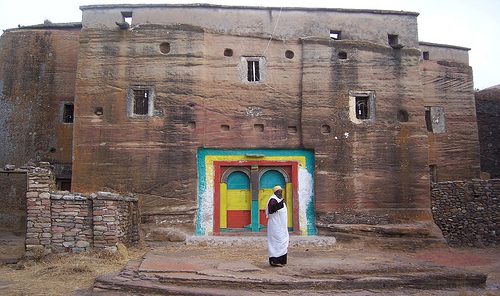Blog
Mikael Barka
Mikael Barka
The rock-hewn church of Mikael Barka can be reached after 18 km drive up the escarpment of the Atsbidera highland plateau east of the town of Wukro. This church is carved from the top of an isolated and roughly round, rock hill. From the top of the hill, one can enjoy a commanding view of the mountain of Tserae and the valley of Womberta to the southeast.
The church has a built facade, which, according to the chief priest, was built in 1967. Two entrances lead from the anteroom to the sanctuary.
It is a three aisled and three bayed square church, 9m wide and 9m deep. It has twelve columns, four of them freestanding and cruciform in design. The bracket capitals are at different heights and the domes and altars are skillfully executed. The ceiling is decorated with a variety of patterns in relief.
Mikael Barka is not known for its wealth of paintings, but one can see murals depicting Saint Mikael. There are also faded murals visible on several columns. Tradition has it that the church was burnt by Queen Judith in the tenth century. According to oral tradition, the edifice is believed to have been sculpted in the 6th century under the auspices of Abune Abraham, an Ethiopian saint. However, David Buxton thinks that the correct date could be the 13th or 14th century.
Visit Ethiopia, Visit Tigray; Visit Atsbi

Mikael Debre Selam is undoubtedly one of the finest churches in its architectural design. It is a church with in a cave or, as Ivy Pearce referred to it, “a church within a church”. The central door leads in to the anteroom with three huge built columns, a beautiful freestanding arch and striking Aksumite “Sandwich Style” constructions (a layer of wood then a layer of stone, painted alternating in black and white). The woodwork of the door and window shutters is exquisitely decorated in geometrical patterns including swastika-like symbols. Especially the middle window shutter is decorated with a 15th century wooden painting of the Virgin Mary and the Child. The ends of the protruding part of the wooden beams are round in shape and their presence adds beauty to the church. It is also known for its wealth of paintings, which can be seen on the walls and arches of the sanctuary, if one asks the priests specifically for it (bring a torch!). The art influence, according to Pearce, is Byzantine but have also unique Ethiopian archtecture. It can be accessed by a 9 km gravel road north east of Atsbi plus a approximately 200 meters road that every one walks on foot.
Hura Seleste (ሁራ ሰለስተ)
Any body who flew to Atsbi Wenberta, he/she definitely get astonished by the number of dancing styles available on the wereda like Hura-Seleste (ሁራ ሰለስተ), Gumaye (ጉማዬ), Tegomtsets (ተጎምጸጽ), Tilhit (ትልሂት), etc. Among all here is the most exciting one and gained popularity in the neighboring woredas of Tigray and Afar regions, is Hura Seleste.
Hura-Seleste evolves from the history of the relation between Atsbians and Axumite kingdom, in which “Royal Axumite Troops” have had guarded their national fervour. It is a type of dancing with an intricate foot work in which the entitled youngsters or men can play on a circular pattern after single Hura song.
The culture and culinary of the woreda is heavily influenced by Enderta, Agame and Raya of the Tigrayans, and the Afars whereby it’s the interface of the four local cultures. Tihilo (ጥሕሎ), Gogo (ጎጎ), Kitcha bMear (ቅጫ ብመዓር), Siwa (ስዋ), and Mies (ሜስ) (Tejj Honey-wine) are the popular foods and drinks. The traditional dance of Hura Seleste is colorful especially during the Ethiopian Christmas. Youths of Atsbi Wenberta make a special thin, decorated with evenly roasted stick called the Birbir. They have songs related only to the Christmas. But, such culture is now declining because of youth migration and influence of other culture.

